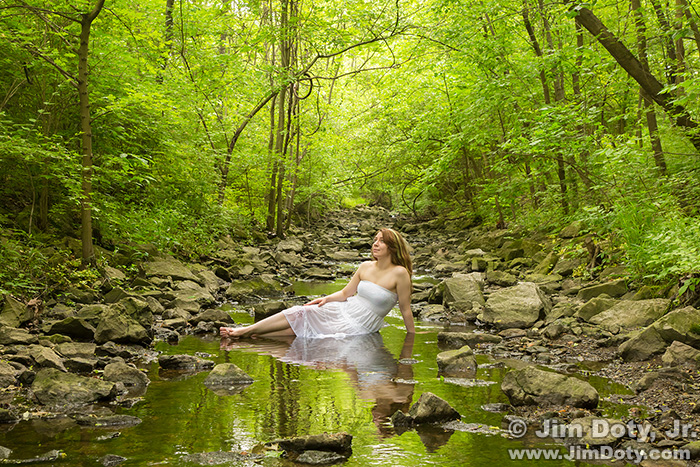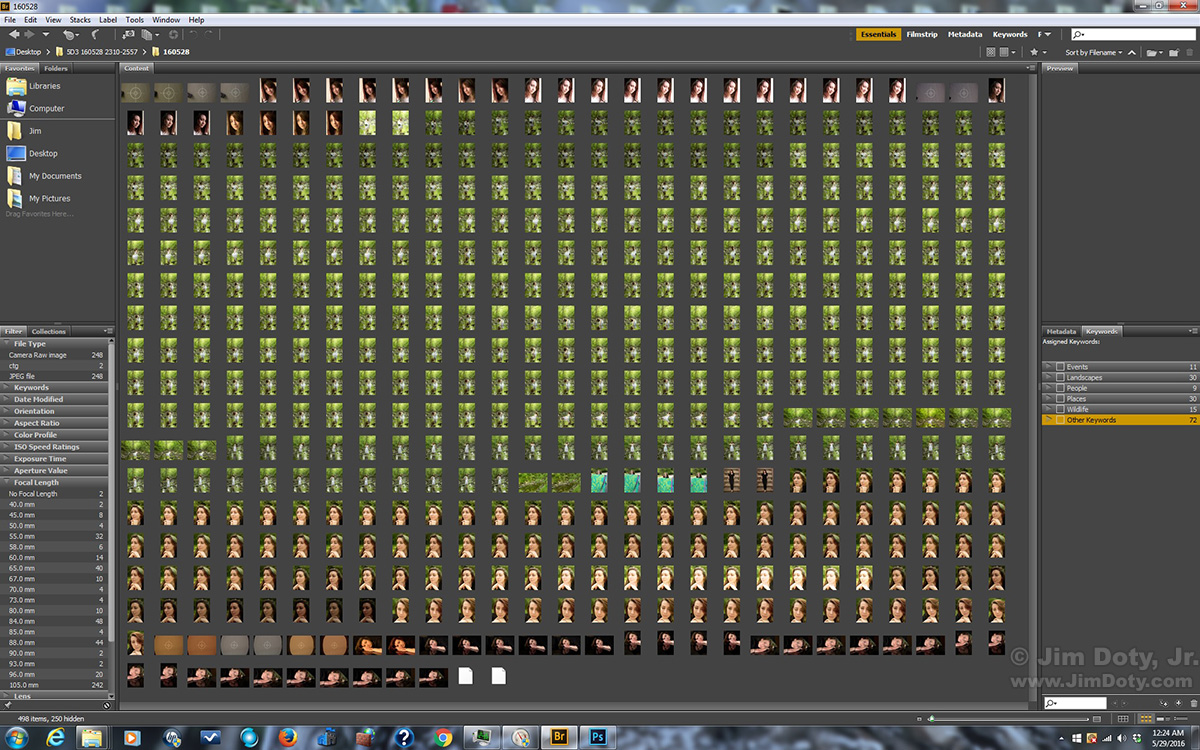My concept was to photograph a young woman in a stream with reflections of her and the trees in the ripples of the water. I had just the right stream in mind and at this time of year there was just enough water. This isn’t the pose I originally had in mind. More about that later.
I wanted to catch the leaves when they still had the light green colors of spring. Leaves darken over time and by summer they would be too dark. In addition the water levels in this stream drop in summer unless there is an unusual amount of summer rain, so this needed to happen in the spring. I also needed a “cloudy bright day” (just enough clouds to have very soft shadows but not so many clouds as to be dark). Not long after we created this image the clouds parted and bright patches of sunlight created bald hot spots here and there, ruining the scene.
I spotted the white dress at Goodwill several months ago and purchased it for this photo shoot. I thought the white dress would go well with the green and show up well as a reflection in the water. The initial concept and pose had been floating around in my head long before I bought the dress.
After Rachel and I worked on the pose I had been thinking about for months, this pose popped into my head. That isn’t an unusual part of the creative process for a lot of photographers. It isn’t surprising to be working on a pre-planned concept and have other ideas show up during the photo shoot. Sometimes the spontaneous ideas are better than the original concept, sometimes not. It is a good idea to go into a shoot with several ideas already in mind, and still be open to new ideas that come to you during the shoot.
To get the reflections I had in mind I needed to be in the water with the camera not too far above the surface of the water. The stream bed is rocky so I was kneeling on the same hard rocks Rachel was dealing with. I did try to pick two flat rocks for the sake of my knees. There is a bridge overlooking this stream and I’ve watched people take pictures from the bridge but you don’t get the same kind of reflections from that high up. I have never seen another photographer take pictures while in this stream. You won’t know what you are missing if you don’t wander around with your camera. Don’t stop after the first good shot. Bring a spare pare of shoes so you don’t spend the rest of the day in soggy shoes. I keep extra shoes and clothes in the trunk of my car (and a towel). Sometimes you have to sit down in the water to get the angle you need.
My backpack with the rest of my gear was on the shore. If you slip and fall you don’t want to risk drowning everything. Unfortunately I ran out of memory card space while we were in the water so I had to head for shore to get another memory card.
The camera was on a tripod for the extra steadiness I needed, and to keep the composition from shifting. When your tripod legs are in the water you should extend the lowest leg sections into the water to keep the lowest leg joints up out of the water. If the water is so deep that you have to get your leg joints into the water, you will need to take the leg sections and joints apart after the shoot and clean them thoroughly or you will have problems with the legs later on.
An aperture of f/11 gave me enough depth of field for both Rachel and the background. I boosted the ISO to get a shutter speed of 1/40 second to keep the water ripples from blurring too much.
The water looked different with each click of the shutter, so I took several images of each pose in the shoot, pre-planned or spontaneous. For this particular pose I took 9 pictures in a little less than 2 minutes.
I did some quick checking of the photos while we were in the water just be sure sure nothing was seriously off. I magnified some of the images to make sure the focus was ok. When we were done in the water (a total of 16 minutes) we both looked at all the photos on the back of the camera to be sure we got what we both wanted. (Sometimes bad things happen to good photographers.)Â If we didn’t get what we wanted we would head back into the water and do it all again. I wouldn’t want to do that, but after all the work and planning and effort and scheduling meshing to pull off a shoot you should be sure you got what you came for.
We made plans to meet the next day (after I had downloaded all the photos) to get a much better look on my laptop. The tiny images on the back of the camera don’t tell you everything.
I take quite a few pictures on a photo shoot with a lot of variations on each pose with adjustments to the body position and angle of the head. For this shoot there was a total of 248 images, including photos of an 18% gray card to set a custom white balance. The total shoot (including several wardrobe changes) lasted two hours. If you look closely at the bottom left corner of the screen capture you can see all of the focal lengths used, from 40mm to 105mm.
The point isn’t to take a lot of photos, the point is to get the shot. The numbers come from doing lots of little and big experiments during a shoot, some of which will work and some won’t. To borrow a few lines from world class National Geographic photographer Dewitt Jones, the question is not “What percentage of keepers did I get from this shoot?” That is the amateur question. The professional question is “Did I get the shot?” So try lots of experiments when you shoot.
My camera is set to capture both RAW plus JPEG files so there are a total of 496 files for the 248 photos. In the great scheme of things that isn’t a lot of photos. If you were in a high end photo studio in NYC watching a shoot for a high dollar magazine, you would see thousands of photos created in a long day for the handful of images that will end up in the magazine.
Photo Data: Canon 5D Mark III. Canon EF 24-105mm lens at 55mm. f/11, 1/40 sec. ISO 1600.


